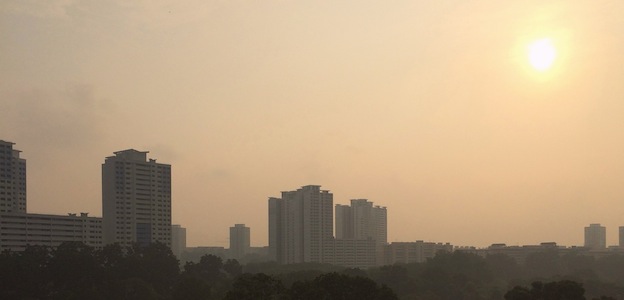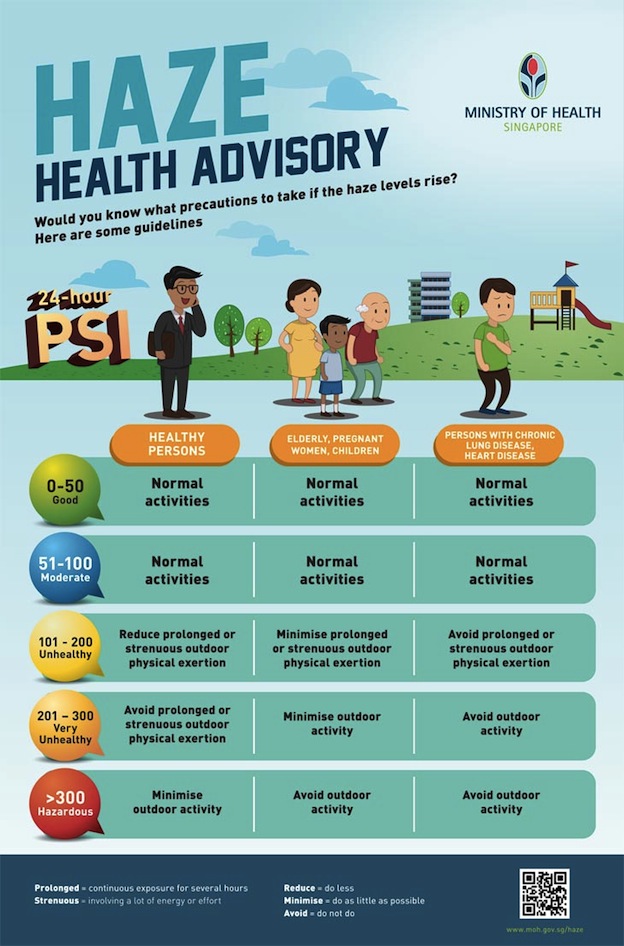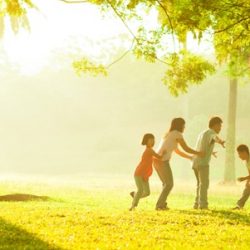SingaporeMotherhood | Parenting
October 2014
Dealing with the Haze

I remember last year’s June school holiday very well. My husband was overseas. Only my two young daughters and I were at home. Thanks to the haze, the view from my tenth floor apartment was a blur. The three of us camped out in one room with the air-conditioner and the air-purifier turned on. We did not go out at all. This year, the haze is back again. But this time, we are better prepared. Are you?
[banner][/banner]
Haze: What is it?
Haze is air-pollution caused by fine airborne particles in the lower atmosphere. These particles sized 10 micrometers or less are known as Respirable Suspended Particles (RSP) because they are small enough to be inhaled.
According to the Health Promotion Board, children, the elderly, people with lung or heart disease, and pregnant women need to be wary of the hazardous pollutants that hazy days bring. See below for guidelines on precautions to take when haze levels rise.
Even healthy individuals will suffer irritation of the eyes, nose and throat when exposed to polluted air over a period of a few days, especially when the Pollutant Standards Index (PSI) reading hits 100 and above. You can check the day’s readings here.
You can check the guidelines for school activities during the haze here.
 Image: Ministry of Health, Singapore
Image: Ministry of Health, Singapore
What You Can Do
1. Use an Air-Purifier (or two)
Recently, the Consumers Association of Singapore (CASE) tested the efficacy of air-purifiers available in the market. The 10 randomly-selected purifiers from various brands all proved to be effective (see results here).
A well-known air-purifier brand also conducted its own tests. It placed two white cotton outfits in two rooms that were filled with tobacco smoke for eight hours, one outfit in each room.
One room had an air-purifier on the entire time, while the other did not. The results were startling. The outfit which was placed in the room without the air purifier was stained to the colour of tea. The one which was in the room with the air purifier remained mostly white.
Khim Lim, a mother of three children aged eight, six and three says, “During the haze last year, the children’s daddy got a bad sore throat. Since then we have bought air-purifiers, so that I hope we will be better protected at home this time.”
Indeed, using an air-purifier can help ease the effects of the haze. However, it has to be used properly, and cleaned periodically. (Lost your air purifier user manual? Don’t worry, most are available for download online.)
When buying an air purifier, choose one that has a High-Efficiency Particulate Air (HEPA) filter as this can help remove pollen, mite allergen, viruses, molds, dust, particles of cigarette smoke and pet dander. Ensure too that your purifier has an active carbon filter that reduces odors.
2. Get an Air-conditioner Filter
Your air-conditioner unit has a filter in it, but you can ‘catch’ airborne particles more effectively with an added filter. This can be bought from any housewares shop. Without an air purifier, this is an affordable way to clean your breathing space, as explained by this blogger father.
3. Use a mask
Earlier this year, many households in Singapore received a ‘Stay Prepared Starter Kit’ from the Government. In it were three N95 masks. I am thankful for it and am keeping it handy just in case the PSI levels increase further. If you’ve chucked yours into the storeroom, it’s time to dig it out!
Gina Lee has two children aged eight and four. Her elderly mother stays with them. Of last year’s haze episode, she recalls, “The whole family was suffering from respiratory ailments like cough, irritated throat and nose, and so on. We all have sensitive noses so we avoided the outdoors as much as possible.
Last year, we couldn’t get any N95 masks, so we made do with three-ply masks. I queued outside Watsons just to get them. When my sister who lives in Japan heard about it, she sent over N95 masks for us. So this year we are better prepared.”
The above-mentioned survey by CASE also checked on face masks. Various brands of face masks priced between $1.38 and $3.90 each were tested. While these work well for adults, they are not suitable for children as they are too large for children’s faces. I have found child-sized masks at some online shops so do surf around if you want to get some for your children.
4. Watch what you eat and drink
It is a good idea to drink more water than usual and cut down on coffee and alcohol as they promote fluid loss. Build up immunity with vitamin-rich food like fruits, nuts and seeds, especially those that contain vitamin A, C and E (which are powerful anti-oxidants).
More precautions to take include rolling up the windows and turning on the headlights when driving, minimising drying clothes outdoors, and keeping soft toys in closed compartments. Last but not least, please keep your pets indoors as well.
5. Stay Informed
You can get more information on the haze here:
Websites:
• National Environment Agency’s Haze Microsite
• Meterological Service Singapore
Apps:
• MyENV on iTunes and Google Play
• Haze@SG (iTunes and Google Play)
• WeatherLah: Singapore Weather App with PSI Trend Widget
• Haze Singapore (iTunes)
• SG PSI Meter (Microsoft)
All content from this article, including images, cannot be reproduced without credits or written permission from SingaporeMotherhood.
Follow us on Facebook, Instagram, and Telegram for the latest article and promotion updates.





